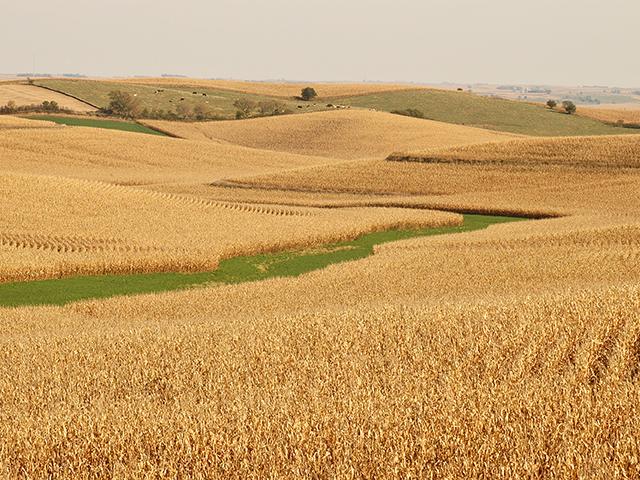Land Values in Period of De-Escalation
Interest Rates Drawing Some Investors Away from Ag Land
Agricultural land price hikes are reported to be slowing in many regions this year, as higher interest rates provide investors with more choices.
Paul Schadegg, senior vice president of real estate operations for Farmers National Company, told DTN their recent midyear report showed a land market that is in a period of de-escalation both in terms of sales volume and rate of value growth. The trend goes back to the last quarter of 2022.
At about 80%, farm operators remain the largest group of buyers through Farmers National Company, but Schadegg noted that the industry is moving into a period of increasing debt service and borrowing.
"This will most likely result in less available cash reserve to deploy for capital expenditures and land purchases," he said.
And while investors haven't always been the winning bidders in the competitive arena of agricultural land buying, Schadegg told DTN they have been an important part of the market, "helping set a floor on land values and creating a competitive market."
That is shifting now, as bonds, CDs, and stocks provide those potential buyers more incentive to look outside of the ag land market, he told DTN.
"Investors will see more opportunity in our changing land market, and then they will have to decide whether they want to make a long-term investment in land," he explained.
"They will decide to look toward long-term appreciation or to capitalize on shorter-term increases in interest rates. It's yet to be seen how investors react. Is now the time for them to jump in, or do they decide to invest elsewhere?"
The answer, as usual, won't be black and white. A lot will depend on the quality of the ag land in question. Schadegg reported that high-quality land is holding its own, or increasing slightly, in value. But lower classes of land have already shown some decrease. Schadegg describes what he's seeing as some pushback on those lower classes, with decreases on that type of land still in the single digits.
Another gray area continues to be climate, especially drought. Schadegg told DTN this is definitely playing a role in land prices.
"There are certain areas, especially out West, where they are in their second -- some even their third year -- of drought. And we are seeing decreases more so in those areas, due to the drought, and/or crop failures related to drought. That's where the pressure is especially strong on land prices," he explained.
SURVEY SHOWS WIDE RANGE ON LAND VALUES MIDYEAR
An agent survey, released midyear by Farmers National Company, showed per-acre prices for high-quality land continued to climb, but at a slower pace.
P[L1] D[0x0] M[300x250] OOP[F] ADUNIT[] T[]
A few examples that compared 2021, 2022 and 2023 average sale prices per acre, all in the month of June, showed these numbers:
-- Arkansas: $5,600 (2021), $6,000 (2022), to $6,300 (2023).
-- Illinois: $12,300 (2021), $15,000 (2022), to $16,000 (2023).
-- Indiana: $9,800 (2021), $12,000 (2022), to $13,000 (2023).
-- Iowa: $11,900 (2021), $15,000 (2022), to $15,400 (2023).
-- Kansas: $4,400 (2021), $5,100 (2022), to $5,800 (2023).
-- Kentucky: $5,000 (2021), $6,200 (2022), to $7,000 (2023).
-- Michigan: $6,500 (2021), $7,600 (2022), to $8,500 (2023).
-- Minnesota: $7,800 (2021), $9,700 (2022), to $10,000 (2023).
-- Mississippi: $5,400 (2021), $5,800 (2022), to $6,000 (2023).
-- Missouri: $6,400 (2021), $7,200 (2022), to $7,500 (2023).
-- Nebraska: $8,800 (2021), $11,500 (2022), to $12,000 (2023).
-- North Dakota: $6,400 (2021), $8,200 (2022), to $8,800 (2023).
-- Ohio: $8,150 (2021), $9,800 (2022), to $11,000 (2023).
-- Oklahoma: $2,500 (2021), $2,900 (2022), to $3,300 (2023).
-- South Dakota: $8,700 (2021), $11,000 (2022), to $12,100 (2023).
-- Tennessee: $4,000 (2021), $4,800 (2022), to $5,200 (2023).
-- Texas: $3,700 (2021), $4,200 (2022), to $4,800 (2023).
-- Wisconsin: $7,000 (2021), $7,900 (2022), to $8,500 (2023).
PRODUCTIVITY WILL BE THE KEY
Ag land values will continue to be closely correlated to productivity and commodity prices, but Schadegg added it's important to add profitability to that mix. He said profitability is what he sees land values hinging on the most in the months to come.
"Profitability is what will determine what the land market will bear," he said. "Landowners continue to look for opportunity in the agricultural land market, deciding if this is the best time to sell at historic values or retain ownership of what continue to be a very valuable asset."
By comparison, he noted that sales volume at Farmers National Company through the first half of 2023 was still exceeding the five-year average but was slightly off the pace set in 2021 and 2022. For the remainder of this year, he said, they are still anticipating strong competition when high-quality land is offered for sale.
"We remain confident that the strong demand for quality agricultural land will continue through the year," he concluded, noting the supply and demand scenario ahead will favor the landowner.
Victoria Myers can be reached at vicki.myers@dtn.com
Follow her on Twitter @myersPF
(c) Copyright 2023 DTN, LLC. All rights reserved.






